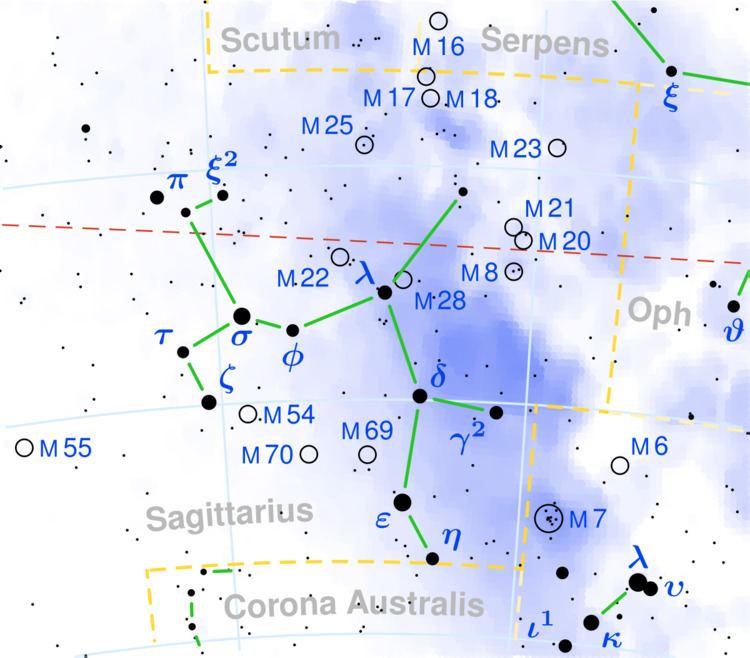Luminosity 1,660 L☉ | Magnitude 3.85 | |
 | ||
Similar | ||
Mu Sagittarii (Mu Sgr, μ Sagittarii, μ Sgr) is a multiple star system in the constellation Sagittarius. It also has the traditional name Polis. μ Sgr is 3,000 light years from Earth and is part of the Sgr OB1 stellar association.
Contents
System
The stars in the μ Sgr system are designated A through E, in order of their distance from the brightest component, which is μ Sgr A. μ Sgr A is also a spectroscopic binary. Of the five visible stars, component C is considered an optical double, not physically close to the other stars. Component D has also been listed as a purely optical double by some authors, but others consider it to be part of a trapezium system of four gravitationally bound stars (plus an unseen companion).
Variability
μ Sagittarii varies in brightness and is classified as a variable star. The two spectroscopic components of μ Sgr A eclipse each other every 181 days, causing a 0.08 magnitude drop in brightness. In addition, it shows more irregular variations typical of an α Cyg variable, irregularly pulsating hot supergiants.
Properties
is a type B giant star with a total luminosity of 180,000 times that of the Sun and a radius of 115 times solar. Its mass is 23 times the solar mass while it has a surface temperature of 11,100 kelvins.
Polis A is an eclipsing binary, bringing the total of stars in the system to six. The primary component is a spectral type B8 supergiant and the companion is a type B2 giant. The orbital period of the binary is 180.55 days. Due to occultation of the primary by the companion, the apparent magnitude of Polis A varies between +3.84 and +3.96.
The remaining components are very weakly bound to the Polis system.
Name and etymology
Uncertainties
Although μ Sagittarii is a naked eye star, the properties of the secondary components are highly uncertain.
The apparent magnitude for component B has been measured at between +8.04 and 10.481, leading to uncertainties about its physical properties, distance, and membership of the system. The Washington Double Star Catalog gives a magnitude of 10.48 and the Catalog of Components of Double and Multiple Stars a magnitude of 11.5.
Component D has an early B spectral type, near B3. The full MK spectral type has been measured as B2 IV, and the assumption of a subgiant luminosity suggests that it is more distant than the other stars of the system. The spectral type has also been estimated photometrically as B2 V, and a main sequence luminosity matches the distance of the other stars.
